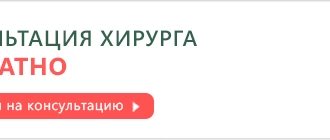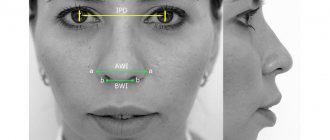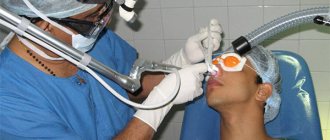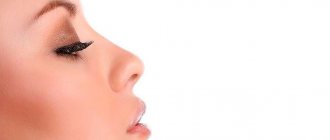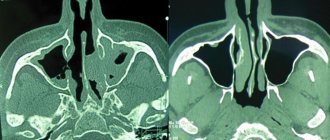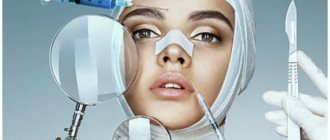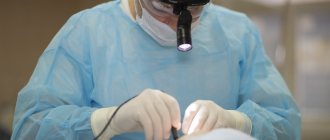The main function of the nasal septum is the correct distribution of air flows between the right and left halves of the nasal cavity.
The nasal septum divides the inhaled air into two equal streams, which ensures their linear movement along the respiratory tract. Optimal conditions are achieved for the nasal cavity to perform its functions (warming, cleansing, humidifying the air). If the configuration of the nasal septum is disrupted, these functions are also disrupted.
In a newborn baby, the nasal septum is always straight and even. It is difficult to distinguish between the bone and cartilaginous parts: almost all of it is cartilage, in which there are several foci of ossification. Gradually they turn into bones and grow together. Violation of this process leads to the occurrence of curvature of the nasal septum. The initial causes of violations that occur cannot always be accurately determined.
Causes of a deviated nasal septum
Classification of causes of deviated nasal septum
| Physiological reasons : associated with heredity and impaired growth of the skull bones. | Traumatic causes | Compensatory reasons : the nasal septum is deformed due to the presence of other pathological formations in the nasal cavity. *** |
| According to statistics, a deviated nasal septum is more common in teenage boys and men. This is the population among which skull and facial injuries are most common. As a result of a strong blow, the nasal bones are displaced. It can lead to curvature of the nasal septum, even if it is minor. The most severe deformities are caused by improper fusion of the nasal bones after a fracture. |
|
|
| |
|
|
What it is?
Septoplasty is an operation to correct defects and deformations of the osteochondral wall (nasal septum), dividing the nasal cavity into the left and right parts.
When the nasal septum is deviated, it moves to one side (usually to the left). Because of this, nasal breathing and the release of mucus from the sinuses are disrupted. Possible causes of a deviated nasal septum:
- physiological - sometimes a deviated septum occurs during fetal development or is caused by a hereditary predisposition
- traumatic - injuries to the face and skull can cause displacement of the nasal septum;
- The natural aging process can affect the curvature of the septum, in some cases this can lead to nasal obstruction.
Moreover, in infants such trauma can occur during childbirth.
Children and adults can suffer injuries that affect the curvature of the septum as a result of an accident. For example, during sports, rough games. Important! Deterioration of nasal breathing due to nasal curvature contributes to chronic inflammation of the paranasal sinuses, middle ear, bronchi and lungs, and impedes the outflow of venous blood from the brain. It is important to perform reconstructive surgery as early as possible in order to prevent the development of infectious complications and oxygen starvation of the body (hypoxia).
Figure 1. Top: Crooked nasal plate. Bottom: The same, but after surgery. Source: Mayo Foundation for Medical Education and Research
GBOU "NIKIO im. L.I. Sverzhevsky" of the Moscow Department of Health
Deformation of the nasal septum, accompanied by its curvature, in many cases is accompanied by a permanent violation of nasal functions.
Deviation of the nasal septum of varying degrees is observed in half of the population, more often in men. Both the bone and cartilaginous parts of the organ can be affected. As a result, the process of normal nasal breathing is disrupted, which serves as a predisposing factor for most diseases in otorhinolaryngology.
In people with this pathology, the nasal passages are narrower on one side than on the other. This changes the airflow pattern and the affected side may be blocked. This “blockade” can cause chronic unilateral sinusitis. Dryness and cracks occur on the skin and mucous membrane of the affected half of the nose, which can cause nosebleeds.
Causes
In almost 90% of cases, a deviated nasal septum is associated with trauma. In newborns, the cause may be intrauterine or birth injury, since the nasal septum in infants is formed by soft, unfused cartilaginous sections that are easily damaged.
Subsequently, as the child grows, the discrepancy between the bony base of the nose and the deformed cartilaginous part increases, and the curvature becomes more noticeable. As a result, not only the shape of the face changes, but also functional breathing disorders develop.
In addition to injuries, the causes of a deviated nasal septum can be:
- congenital malformations of the facial part of the skull, for example, cleft palate;
- polyps and tumors of the nasal cavity;
- severe infectious diseases, chronic rhinitis.
Taking into account the listed factors, all causes of pathology are divided into groups:
- physiological, associated with the characteristics of the growth and development of cartilage and bone tissues of the nose;
- traumatic, caused by a mechanical factor, and the victim often does not even remember the seemingly minor injury;
- compensatory, caused by pathology of the nasal passages (tumor, polyp and others).
Features of septal deformation during a fracture depend on the direction of impact during a nasal injury:
- in case of injury to the tip of the nose, the bony base of the septum is not damaged, but as the child grows, the terminal part of the nose turns to the side; with a strong blow, a septal abscess may form in the future;
- when there is a blow to the back of the nose from the front, two scenarios are possible: if initially there was already a curvature of the nasal septum, it will break in the same direction; if the straight septum is damaged, the shape of the nose may not change;
- if a blow to the back of the nose comes from above, it always causes a fracture of the nasal bones; in this case, the back of the nose sinks, and subsequently its saddle-shaped deformation is formed;
- when the nose is hit from the side, the nasal septum can bend in the corresponding direction, causing deformation of the external nose or displacement of its back, sometimes with such an injury the sense of smell suffers;
- in case of damage caused by a fall on the face (for example, in an accident), the nature of the damage is varied; the nasal septum is often “crushed”, which is combined with injuries to the ethmoid bone, base of the skull, and fractures of the walls of the paranasal sinuses.
Determining the cause and mechanism of the curvature of the nasal septum is necessary for the doctor to determine the correct treatment tactics.
Symptoms
Clinical manifestations of a deviated nasal septum can be divided into general and local. Local ones include:
- unilateral difficulty breathing through the nose, a feeling of stuffiness in one nostril;
- impaired sense of smell and mucus discharge from the affected nostril;
- nasal sound and snoring, hearing loss;
- nosebleeds due to frequent injuries to dry mucous membranes;
- violation of the normal shape of the external nose.
Common symptoms are associated with insufficient nasal breathing function, as a result of which less air enters the lungs and the body experiences chronic oxygen starvation:
- fatigue; the child has poor performance at school;
- paroxysmal headache;
- child's retardation in mental and physical development;
- frequent colds.
The more pronounced the curvature of the nasal septum, the more often the general symptoms appear. They are especially dangerous for the development of a child.
Often this pathology is accompanied by other diseases, possibly associated with impaired breathing through the nose. These are vasomotor and allergic rhinitis, otitis media, adenoids, chronic sinusitis, tonsillitis, bronchial asthma.
With a significant deviated septum, the patient complains of dry mouth, a feeling of pressure in the nasal passages and sleep disturbance due to the inability to breathe through the nose.
Classification
It is often used to divide all deformations of the nasal septum into the following categories:
- slight displacement of the anterior section to the side with normal function;
- slight displacement in the same place, but with impaired nasal function;
- displacement of the septum at the level of the anterior end of the middle turbinate;
- a combination of the two previous types on different sides of the nasal cavity;
- ridge in the basal (posterior, main) section of the septum on one side;
- ridge in the anterior-basal part with a depression on the opposite side;
- combined disorder.
A “working” classification is also used, convenient for choosing the method of operation:
- C-shaped deflection;
- S-shaped deformation;
- ridge or spike on the septum;
- combined forms;
- vertical displacement of the partition up or down;
- dislocation or tearing of the cartilaginous part of the nasal wall;
- a structural anomaly involving the vertical plate of the ethmoid bone.
Diagnostics
A deviated nasal septum can be recognized using anterior rhinoscopy. This is a simple, painless procedure to examine the inside of the nose. However, this study is not enough to determine the indications for surgery.
The ENT doctor takes into account the following factors:
- degree of dysfunction (breathing, smell, resonator);
- patient complaints and concomitant diseases;
- the severity of the deformity, which is assessed using functional endonasal endoscopy, and in severe cases, computed tomography of the facial skull.
Before surgery, the patient is prescribed an x-ray of the nose and paranasal sinuses. If adenoids or signs of sinusitis are detected, these conditions must be treated first to avoid complications of surgical treatment.
Treatment without surgery
In mild cases of deformity, treatment without surgery is possible. It is aimed at eliminating unpleasant symptoms. The doctor may prescribe the following medications:
- decongestants (decongestants) that improve nasal breathing; however, these drugs cannot be taken for a long time;
- antihistamines, especially with concomitant hay fever;
- nasal sprays with glucocorticoids, which reduce inflammation and improve breathing.
Medicines only temporarily eliminate the symptoms of the disease, without eliminating its cause.
Another method of treatment without surgery in the generally accepted sense of the word is laser techniques. Laser septoplasty involves “cauterizing” a protruding part of the nasal septum with a laser beam. This technique is used for minor deformation.
Laser chondroseptoplasty is a fairly effective treatment method, during which laser radiation heats the nasal cartilage and makes it flexible. After this, the surgeon manually straightens the shape of the septum and fixes it with tampons. This intervention is minimally invasive, bloodless and practically safe.
Types of surgical treatment for deviated nasal septum
Despite the development of laser technologies, conventional septoplasty is still practically the only way to get rid of a deviated nasal septum.
Indications for septoplasty:
- chronic or recurrent diseases of the nose and paranasal sinuses;
- difficulty breathing through the nose on both sides;
- recurrent otitis and eustachitis;
- chronic purulent sinusitis;
- snoring, obstructive sleep apnea syndrome;
- headaches, constant weakness, signs of oxygen starvation of tissues;
- unaesthetic appearance of the patient.
Treatment of a deviated nasal septum can be carried out in different ways:
- operations that preserve nasal tissue;
- interventions with partial resection (removal) of tissues and their replacement with so-called non-free grafts from parts of the nasal walls;
- resection interventions with replacement of the resulting defect with a free graft.
In children, tissue-sparing operations are usually performed and endotracheal anesthesia is used. The degree of intervention depends on the severity of the anatomical defect. The success of the intervention largely depends on the experience and qualifications of the surgeon.
When performing a septoplasty, the surgeon makes a small incision in the septum and then removes excess bone or cartilage that is obstructing breathing. In some cases, to improve the external shape of the nose, correction of the external nose is performed at the same time. Both of these operations can be combined with intervention on the paranasal sinuses.
Septoplasty can be performed using modern endoscopic equipment, which reduces the risk of complications and speeds up the healing process of the postoperative wound.
Surgery to correct a deviated septum is usually performed on an outpatient basis under local or general anesthesia and takes about one to one and a half hours, depending on the extent. Often, 3 to 4 hours after the intervention, the patient can go home without staying in the hospital.
To stabilize the septum, cotton swabs are placed in the nasal passages and subsequently removed. If only septoplasty was performed, it is not accompanied by swelling or hemorrhages on the face. With concomitant correction of the external nose, slight swelling in the nasal area remains for several days.
The operation can be performed on children starting from preschool age, but many doctors recommend doing it after 15 years, when the formation and growth of the nose has completed.
After the nasal septum is restored, a course of antibiotics is prescribed. At the same time, vasoconstrictors, wound healing, and decongestants are used. The sutures are removed on days 5–6.
Contraindications to surgery include severe concomitant diseases and conditions:
- heart failure FC III – IV;
- myocardial infarction or stroke suffered over the past six months;
- decompensated diabetes with high levels of sugar and/or glycated hemoglobin in the blood;
- malignant tumors;
- acute infections, exacerbation of chronic inflammatory processes;
- bleeding disorders with hemorrhagic syndrome;
- dysmorphophobia is a mental disorder accompanied by unreasonable dissatisfaction with one’s appearance and inflated expectations from surgical intervention.
Treatment of a deviated nasal septum is effective in 90% of cases. After the operation, the patency of the nasal passages increases, nasal breathing and the function of the paranasal sinuses are restored, and other symptoms of the disease disappear.
In order to treat a deviated nasal septum, we invite patients to the specialists of NIKIO named after. L.I. Sverzhevsky DZM. The most experienced ENT doctors work here, who do an excellent job of restoring the normal shape of the septum. The extensive experience of surgeons allows operations to be performed without complications and with excellent long-term results.
Elimination of the curvature of the nasal septum is carried out exclusively surgically - septoplasty, cristotomy is possible endoscopic, with isolated minimal cartilage deformation - laser septochondroplasty using a holmium laser (Ho:YAG) with a radiation power of 4.8 W (energy - 0.6 J, frequency - 8.0 Hz) . We complete septoplasty by splinting the nasal septum with silicone splints. The latest development reduces the risk of such complications as hematoma of the nasal septum, reactive swelling of the mucous membrane of the nasal septum, and protects the nasal septum from traumatic factors in the postoperative period.
Our department has received patents for inventions on methods of treating deviated nasal septum:
- Utility model patent No. 81425 “Intranasal splint (variants and method of its fixation)
- Patent for invention No. 2414180 “Intranasal splint (variants) and method of its fixation.”
- Patent for invention No. 2493790 “Intranasal splint with integrated electrode.”
- Patent for invention No. 2493783 “Method of fixation of displaced mucoperichondrial flaps of the nasal septum with a “reverse” U-shaped suture.”
Indications
In mild cases, when the deformation of the septum does not interfere with the movement of air, surgery is not indicated. Surgical correction is necessary if:
- breathing through the nose is so impaired that the quality of life suffers;
- sinusitis (inflammation of the mucous membranes of the paranasal sinuses) recurs;
- frequent nosebleeds;
- significant cosmetic defect;
- pronounced snoring.
Figure 2. On the left is a deviated septum.
On the right - healed, after surgery. Source: houstonadvancedsinus.com Sometimes septoplasty is performed as a stage of a complex operation to correct maxillofacial malformations (cleft palate or cleft lip).
Postoperative care and observation
- — in a hospital, postoperative care includes, first of all, the regime and observation by a doctor of the healing process. The patient does not perform any actions independently without the recommendation of the surgeon.
- — after discharge from the hospital, the patient spends the first week at home. It is recommended to maintain a home regime, avoid increased physical activity, crowded places, and follow the recommendations. Often, nasal rinsing with large volumes of saline solution, up to 1 liter (Dolphin, Aqua-Maris, etc.) is prescribed.
- — after returning to work, the patient must gradually enter the natural rhythm of life, slowly increasing physical activity to the usual level. Significant, exhausting loads, visits to the pool, baths, saunas, exercise in the gym, flights, business trips are recommended to be postponed for 1 month after the operation for normal recovery of the body. Often, the surgeon will schedule a follow-up examination 2-4 weeks after surgery to monitor the recovery process.
Contraindications to septoplasty:
- coagulopathies (insufficient blood clotting with increased bleeding);
- chronic liver and kidney diseases;
- infections in the active stage;
- allergy to anesthetics;
- somatic diseases in the stage of decompensation (diabetes, heart disease, etc.).
Important! Since the septum is the “centre of growth” of the nose, correction of its shape is not recommended for girls under 16, and for boys under 17–18 years old. In these cases, surgery is performed only for emergency reasons, for example, after a nasal injury or to correct developmental abnormalities.
Causes of a crooked nose
There are three main reasons.
- Physiological is the most common problem. Asymmetry develops gradually during the active formation of the facial skeleton in childhood. Chewing has a great influence on the proper growth of cartilage and tissue. For example, during the period of change from milk teeth to permanent ones, the chewing load is distributed unevenly, which is why the facial bones become thicker in those places where the pressure is stronger.
- Post-traumatic is another cause of curvature. Often, injuries lead to displacement of the cartilage inside the nasal passages, even in the absence of external signs.
- Compensatory – occurs quite often. Asymmetry develops due to the presence of foreign bodies and enlarged polyps in the nasal cavity. The cause of curvature can be various infectious diseases and errors during operations.
The most difficult cases are associated with the consequences of unsuccessful rhinoplasty. Many patients turn to the surgeon again due to an unsatisfactory result: the formation of lumps, protrusions and even greater curvature than it was before the intervention.
What types of surgery are there?
There are two options for nasal septum correction: the traditional open method and the endoscopic method. The first involves direct access to the osteochondral wall through the nostrils. The second allows you to visualize the surgical field in all details using an optical device - a rigid endoscope. Such operations are performed quickly, and the risk of postoperative complications is negligible.
Types of septoplasty:
- The traditional open method (submucosal resection of the nasal septum) involves direct access to the osteochondral wall through the nostrils.
- Endoscopic method - allows you to visualize the surgical field in all details using an optical device - a rigid endoscope. Such operations are performed quickly, and the risk of postoperative complications is negligible.
How is rehabilitation after septoplasty?
With the development of technology, septoplasty has ceased to be uncomfortable. The operation begins with the patient being given anesthesia, then the doctor uses an endoscope, through a small incision, to enter between the layers of the mucous membrane and straighten the septum.
During the rehabilitation period, technologies were also created that allow the patient to avoid unpleasant sensations and breathe through the nose. Intranasal septal splints according to Reiter or splints were created. They are made of soft silicone, as it does not cause any harm to the nasal cavity and is painlessly removed from it. The splints have a seven-sided shape, which completely follows the shape of the nasal septum at the site of the operation. The essence of splints is that they keep the septum in the midline. After the operation, while the patient is under anesthesia, a silicone splint is sewn on.
Splints come in different modifications. Depending on the shape of the nose, they can be either large or small. A tube can also be inserted between the silicone of the splint, through which the patient can breathe immediately after the operation. The septal splint stays in the nose for about 5-7 days, during which time the nasal septum takes its position.
How does the nasal septum correction process work?
This surgical intervention is performed in the ENT department as planned: after the examination, the patient is admitted to the hospital. The procedure takes about an hour. If the postoperative period is calm, you can return home the next day and undergo recovery on an outpatient basis.
Photo: Archives of plastic surgery / Open-i (Attribution-NonCommercial 3.0 Unported)
How to prepare for surgery
- 2 weeks in advance, stop taking medications that affect blood clotting - anticoagulants (Aspirin, ThromboASS, Acetylsalicylic acid, etc.) It is necessary to consult your doctor before stopping anticoagulants. If the medications cannot be discontinued, notify the surgeon about this and talk to the attending physician about a possible change in therapy.
- in the presence of concomitant diseases (coronary artery disease, hypertension, bronchial asthma, peptic ulcer, etc.), consult with your doctor about the possibility of surgery and the need for preoperative preparation.
- 2 weeks before surgery it is advisable to stop smoking and not drink alcohol
- for women - stop taking hormonal contraceptives 1 month before surgery or consult a gynecologist. This is especially important if you have varicose veins.
- If you have severe dry nose, then 2-4 weeks before surgery you should consult with the operating ENT surgeon. Dry mucous membranes and significant crusts can adversely affect the operation and postoperative period.
Diagnostics
An ENT doctor may detect a deviated septum during an examination. Bright light and a nasal speculum are usually sufficient to make the diagnosis. If concomitant pathology of the nasal structures is suspected, a computed tomography scan is prescribed.
Before the operation, the following examinations will be prescribed:
- clinical and biochemical blood tests;
- chest x-ray (especially important for patients over 45 years of age, smokers, and those with heart or lung disease);
- electrocardiogram.
Cost of treatment
The complex cost of treatment for a deviated nasal septum (septoplasty in St. Petersburg) ranges from 65,000 rubles. up to 78,000 rub.
Depends mainly on the comfort of the room and the length of stay in the hospital.
You must understand that the final price does not consist of the cost of the operation itself (which is 17,500 rubles), but of the prices for all services provided during the treatment process: surgery on the nasal septum and nasal turbinates, anesthesia, hospital stay, doctor’s manipulations and nurses. In the presence of concomitant pathology, such as chronic sinusitis (sinusitis), neoplasms of the paranasal sinuses (cysts, polyps), the cost increases when eliminating this pathology.
Click the "Submit" button. Find our request for patient personal data and medical documents in your email. Answer all questions in the questionnaire and add your own questions. How to prepare medical documents for preliminary analysis: - create a folder in cloud.mail.ru (or in any other storage, ...) - upload medical document files there (scans, photos, archive), - copy the link to the folder in the cloud , - insert the link into the letter with the questionnaire. Please note: one patient - one letter. Your letter is analyzed by an active surgeon (and, if necessary, a council of specialists) in his free time from his main job. Thank you for your attentiveness to the instructions and clarity of wording. There are still questions
Researcher, ENT surgeon of the highest category, Ph.D. Sergey Alekseevich Eremin.
Possible complications:
Photo: Allergy & rhinology (Providence, RI) / Open-i (Attribution-NonCommercial-NoDerivs 3.0 Unported)
- uncontrolled bleeding;
- infection;
- perforation of the septum;
- changing the shape of the nose;
- impaired sense of smell;
- temporary numbness of the gums of the upper dentition;
- hemorrhage under the mucous membrane of the septum.
Symptoms of a deviated nose and nasal septum
A slight degree of curvature is visually almost invisible and is not accompanied by unpleasant symptoms. With severe deformation, you can find:
- uneven volume of tissue on the wings of the nose;
- curvature of the tip;
- different size of nostrils;
- S-shaped bend of the nasal bridge.
External defects do not cause physical discomfort, while a deviated septum provokes real problems:
- nasal congestion without signs of rhinitis;
- constant headache;
- night snoring with temporary pauses in breathing (apnea);
- pain and congestion in the ears;
- nasal voice;
- constant coughing;
- runny nose that does not go away;
- tendency to colds and ARVI;
- frequent sneezing;
- dryness of the nasal mucous membranes;
- decreased hearing acuity;
- soreness and sore throat;
- wheezing and difficulty breathing.
Constant lack of air due to the need to breathe through the mouth leads to disruption of cardiovascular activity, changes the secretion of mucous membranes, and reduces brain function. All this negatively affects well-being, performance, and psycho-emotional state.
Most of these symptoms are associated with various ENT diseases, so patients learn about nasal curvature during an examination for ear infections and nasopharyngeal diseases. And then they come for a consultation with plastic surgeons.
Benefits of treatment under compulsory medical insurance
Surgical correction of curvature is an expensive surgical procedure.
But with a compulsory medical insurance policy, you can restore your health and save good money. The state cares about the right of citizens to free medical care, provides financing, so there is no need to pay again. Despite the well-established opinion that it is impossible to get quality treatment without money, you need to demand an appropriate attitude. In fact, the treatment of the insured is already paid for in the form of taxes from wages. And the insurance company that issued the compulsory medical insurance policy will help you sort out all controversial issues.
Rehabilitation
The rehabilitation phase after submucosal resection is critical. Following recommendations from doctors reduces the overall duration of the postoperative period, speeds up healing, reduces the discomfort of the recovery stage, and helps to avoid complications.
It is important to maintain proper nasal care. At first, you should absolutely not blow your nose and try to prevent sneezing. These actions can provoke perforation of the mucous membrane. You can clean the nasal passages using rinsing or auxiliary items (wet wipes, cotton swabs).
During the active recovery period (approximately 3 months), do not wear glasses to avoid pressure on the bridge of the nose, engage in intense physical activity, be exposed to ultraviolet radiation, take hot baths, or sleep on your side or stomach.
